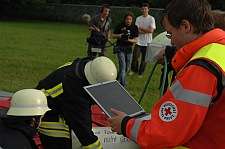Saving lives with 10-kilo phone network

A ten-kilo GSM mobile phone network developed by European researchers will allow rescue workers to set up communications just hours, or even minutes, after a man-made or natural catastrophe. It will mean more lives saved.
When disaster strikes communications are often one of the first infrastructures to go down. But it is exactly when effective communications are most desperately needed.
That problem may be a thing of the past thanks to achievements in the EU-funded WISECOM project. WISECOM stands for Wireless Infrastructure over Satellite for Emergency Communications, and the team behind the project has developed hardware and software allowing rescue workers to respond faster in the wake of a catastrophe.
“We developed lightweight, portable (or transportable) systems that allow rescue workers to set up voice and data networks in a very short time,” says Matteo Beriloli, WISECOM’s coordinator.
The hardware can then link up to satellites to connect with the world mobile and landline networks, says Beriloli. “The system works anywhere there is satellite coverage, which is to say almost everywhere in the world,” he adds.
Suitcase-sized cell
The system comes in two versions, which exploit two different satellite technologies: Inmarsat BGAN and DVB-RCS. BGAN, a satellite telephony standard, is smaller with lower performance, while DVB-RCS is a satellite broadcast standard and has much better performance, but is much larger.
The version working with BGAN is portable, the size of a small suitcase, and weighs just 10kg. It can be carried on a standard flight and delivered to the disaster zone, where non-technical rescue workers can set it up in minutes. The DVB-RCS version is larger and heavier, weighing 60kg – about the size of two fairly large suitcases.
“Most of the volume in the DVB-RCS version is taken up by a satellite dish,” reveals Beriloli.
Both systems come with an integrated GSM network and wifi connection. The BGAN version integrates a GSM pico-cell – tiny mobile phone cell using the internet to connect to the public phone service – and offers coverage of over 300m radius for voice and data, while the DVB-RCS version integrates a GSM micro-cell which can cover several kilometres and it benefits from a larger bandwidth on the satellite connection.
The BGAN version is for immediate deployment during the initial emergency response, while the DVB-RCS one has longer deploying times, mainly because the 1.2m satellite antenna has to be carefully pointed. It is intended to help reconstruction efforts in the days and weeks after a disaster.
In addition to the hardware, WISECOM developed useful software to maximise the impact of the system. Location Based Services (LBS) allow emergency chiefs to track rescue workers as they seek out disaster victims.
“It is fundamental with triage, [helping to determine] which cases require the highest priority,” Beriloli offers as an example. “We only discovered the importance of this service when we talked to end-users.”
Novel suggestions
Indeed, one novelty of the WISECOM project is that user suggestions are a vital part of its work plan. “Engineers can create perfect technology, but often in the past it did not always correspond to real needs. We included end-users as part of the consortium to make sure we were developing relevant systems.”
The LBS for triage is a case in point. Coding triage victims by colour – black, red, yellow or green – is an internationally recognised system. Black denotes a fatality; red someone who is near death, yellow is serious but not life-threatening, while green signals an injury.
“If a victim is red, the rescue worker notes that and the LBS software immediately, via WISECOM, tells the command centre where to find the victim. Then command can alert other rescue workers and establish voice communication [with] specific people to speed up the rescue, ” Beriloli explains.
All this – voice and data, GSM and WiFi – runs over WISECOM and the satellite. So the command centre could even be on the other side of the world, thanks to the satellite link-up.
Extra functionality
LBS and this system of electronic triage is just one example of the extra functionality the team built into the system. Tetra is another example.
“Tetra is the new communication standard, that serves the needs of emergency response and public safety,” says Beriloli. “There is currently a very big push for this standard in Europe,” he notes.
Tetra was not part of WISECOM’s original brief, but the team developed a solution within their system for this standard.
“We did not produce a full demonstrator, but we proved the functionality in the lab. It could be easily scaled up for real-world use. We did not have to do it, but it was very relevant to our system, so we were keen to do the work,” adds Beriloli.
Once all these elements were complete, the WISECOM team tested the entire system in a live demonstration. “I was impressed by how many people were involved. There were over 150 people and 25 vehicles: fire trucks, ambulances,… everything. We gave the rescue workers some training, but they did everything on the day, setting up the WISECOM system and going through an emergency drill. It worked very well,” the coordinator confirms.
Commercial opportunities
Now the system is ready for commercialisation, and some of the partners are actively pursing opportunities – though, in part, that will depend on public services. “These types of systems are generally purchased by governments, or civil security forces,” notes Beriloli.
WISECOM, which was funded by the Sixth Framework Programme for research, had another unexpected impact. “It has put satellites on the map for emergency communications. There are not many people working in this area, and it has suddenly become a hot topic, because people have understood the potential of satellites in emergency situations, when terrestrial infrastructures are not reliable or [no longer] available. For this reason, I assume, I was invited to chair the satellite workgroup on the EU’s Public Safety Communications Forum.”
Provided by ICT Results





















